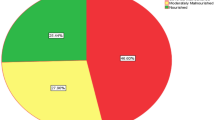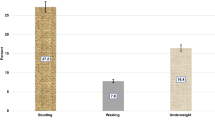Abstract
Objective: The study's main objectives were the identification of determinants of growth failure in 12–24-month-old children from an urban slum community attending a day hospital as well as the identification of focus areas for intervention.
Design: The research was executed as a case–control study with a one-to-two design. A hypothetical causal model was developed for the undernutrition situation in Duncan Village. A questionnaire to assess the direct and underlying causes of growth failure in the study population was developed from this model.
Subjects: One-hundred and fifty children were selected for the study, with 100 children in the control group and 50 children in the growth-failure group. Each child in the growth-failure group was matched with two children in the control group based on age and sex. The children were chosen according to anthropometric indices and p-albumin levels.
Setting: The research was conducted at a primary health care centre in Duncan Village, an overpopulated urban slum area in East London, a small city on the east coast of South Africa.
Results: No significant differences were found between the two groups for the occurrence of disease and infection. Dietary intake seemed to be generally poor in all the children. No significant differences were found between the two groups for the indicators of household food security, health service utilization and environmental conditions. The most important underlying determinants of growth failure that were identified in the study population seem to be related to the caring capacity, and the resultant caring behaviours of mothers. The risk for growth failure is increased when a child has a mother who is not the head of the household (relative risk) (RR=4.3), who is not involved with the discipline of her children (RR=2.2), who is not the guardian of the child (RR=8), who was not born in Duncan Village or in a city (RR=2.16), who is not able to write (RR=2.7) or read Xhosa (RR=2.53), who has a school education of ≤grade 9 (RR=2.9), who did not receive nutrition education (RR=2.2), who smokes (RR=10) and drinks beer regularly (RR=10), who has a BMI <25 (RR=2.7), who was subjectively judged to show little interest in her child (RR=4) as well as an inadequate caring attitude towards her child (RR=3.61), and whose clothing was dirty (RR=2.7) and not tidy (RR=2.9). Further determinants included the following: a child who weighed <2500 g at birth (RR=4.96), who had not received supplemental milk while still breast-fed (RR=2.00), who did not receive baby cereal as first food (RR=2.6), whose clothes (RR=2.7) were dirty and whose hands were infrequently washed (RR=10).
Conclusions: The results of this research suggest that initiatives to address the problem of growth failure in 12–24-month-old children attending the Duncan Village Day Hospital should focus mainly on improving the caring capacity of mothers in the study area.
Sponsorship: This research was sponsored by the Frere Hospital in East London.
This is a preview of subscription content, access via your institution
Access options
Subscribe to this journal
Receive 12 print issues and online access
$259.00 per year
only $21.58 per issue
Buy this article
- Purchase on Springer Link
- Instant access to full article PDF
Prices may be subject to local taxes which are calculated during checkout


Similar content being viewed by others
Notes
1 Euro=R10.40 (March 2002).
References
ACC/SCN. 1992 Second Report on the World Nutrition Situation. Volume 1. Global and Regional results Geneva: ACC/SCN, United Nations
Atkinson SJ . 1995 Approaches and actors in urban food security in developing countries Habitat Int. 19: 151–163
Bank L, Lujabe P, Mlomo B . 1995 Poverty in Duncan Village, East London: a qualitative perspective Report for the World Bank. Institute of Social and Economic Research Grahamstown: Rhodes University
Bank L, Jekwa M, Lujabe P, Mlomo B . 1996 Small business development in Duncan Village: towards a new development framework Report of the Institute of Social and Economic Research East London: Rhodes University
Beaton GH, Ghassemi H . 1987 Supplementary feeding Programs for young children in developing countries: a summary of lessons learned In: Food Policy: Integrating Supply, Distribution and Consumption ed. JP Gittinger, J Leslie & C Hoisington London: Johns Hopkins University Press
Beaton G, Kelly A, Kevany J, Martorell R, Mason J . 1990 Appropriate uses of anthropometric indices in children ACC/SCN State-of-the-Art Series. Nutrition Policy Discussion Paper no. 7 Geneva: United Nations
Dannhauser A, Pretorius L, Terblanche Y, Van der Merwe SJ, Van der Meyden LF, Venter UL, Wait A, Wessels AM, Nel R . 1996 Nutritional status of preschool children in the Ladybrand district Presentation at the ‘Hands On’ Nutrition Congress, Stellenbosch, South Africa
Department of Health and Welfare (South Africa). Gids vir Gesond Eet Pamphlet Pretoria: South African Department of Health and Welfare
De Villiers A . 1998 The identification of determinants of growth failure and focus areas for the prevention thereof in 12 to 24 month old children attending the Duncan Village day hospital in East London MSc Thesis, University of Stellenbosch, Stellenbosch
Dhansay MA, Hendricks MK . 1994 A literature review and technical perspective of protein energy malnutrition in SA and local and international intervention studies National Research Programme for Nutritional Intervention of the Community Health Research Group Tygerberg: Medical Research Council
Dickin K, Griffiths M, Piwoz E . 1997 Design by Dialogue A program planner's guide to consultative research for improving young child feeding. Support for Analysis and Research in Africa USAID, Bureau for Africa, Office of Sustainable Development
Eck LH, Klesges RC, Hanson CL . 1991 Reporting retrospective dietary intake by food frequency questionnaire in a pediatric population J. Am. Diet. Ass. 91: 606–608
Faber M, Oelofse A, Kriek JA, Benadé AJS . 1997 Breastfeeding and complementary feeding practices in a low socio-economic urban and a low socio-economic rural area S. Afr. J. Food Sci. Nutr. 9: 43–51
Fabricius MP, McWilliams JA . 1991 Population development survey of five magisterial districts in the Republic of Ciskei Research Report no. 42 Institute for Planning Research, University of Port Elizabeth
Ferrinho P de L GM, Gear JSS, Reinach SG, Bac M . 1991 Early life nutrition in the Gelukspan Health Ward S. Afr. Med. J. 80: 588–591
Gillespie S, Mason J . 1991 Nutrition relevant actions: some experiences from the eighties and lessons for the nineties ACC/SCN State-of-the-Art Series. Nutrition Policy Discussion Paper no. 10 Geneva: United Nations
Horwarth CC . 1990 Food frequency questionnaires: a review Austr. J. Nutr. Diet. 47: 71–76
Huffman SL, Martin LH . 1993 First feeding: optimal feedings of infants and toddlers Nutr. Res. 14: 127–159
Huttly SRA, Victora CG, Barros FC, Teixeira AMB, Vaughan P . 1991 The timing of nutritional status determination: implications for interventions and growth monitoring Eur. J. Clin. Nutr. 45: 85–95
Iputo JE, Makuzeni E . 1993 The dietary pattems of the urban and rural Transkeian children with protein-energy malnutrition S. Afr. J. Clin. Nutr. 6: 6–10
Jonsson U . 1996 Nutrition and the convention on the rights of the child Food Policy 21: 41–55
Kibel MA, Wagstaff L . 1995 Child Health for All: a Manual for Southem Africa 2nd edn Oxford: Oxford University Press
Kurz KM, Johnson-Welch C . 2000 Enhancing Nutrition Results: the Case for a Women's Resources Approach ICRW/OMNI
Labadarios D (Ed). 1999 The National Food Consumption Survey (NFCS): Children aged 1–9 y in South Africa: executive summary Pretoria: Directorate, Nutrition, Department of Health
Langenhoven M, Kruger M, Gouws E, Faber M . 1991 MRC Food Composition Tables 3rd edn Parow: Medical Research Council, National Programme: Nutrition Intervention
Lee RD, Nieman DC . 1993 Nutritional Assessment Oxford: Brown & Benchmark
Le Roux IM, Le Roux PJ . 1991 Survey of the health and nutrition status of a squatter community in Khayelitsha S. Afr. Med. J. 79: 500–503
Maclean WP . 1987 Nutritional risk: concepts and implications In: Food Policy: Integrating Supply, Distribution and Consumption ed. JP Gittinger, J Leslie & C Hoisington London: John Hopkins University Press
Patel N, Pettifor JM . 1992 Malnutrition in South Africa S. Afr. J. Food Sci. Nutr. 4: 22–23
Potgieter JF . 1990 The household subsistence level in the major urban centres of the Republic of South Africa, March 1990 (Fact Paper no. 82) Institute for Planning Research, University of Port Elizabeth
Range SK, Kumar RN, Saroj B . 1997 Child care practices associated with positive and negative nutritional outcomes for children in Bangladesh: a descriptive analysis Discussion paper no. 24 Food Consumption and Nutrition Division. Washington, DC: International Food Policy Research Institute
Ricci JA, Becker S . 1996 Risk factors for wasting and stunting among children in Metro Cebu, Philippines Am. J. Clin. Nutr. 63: 966–975
SAS Institute Inc. 1992 SAS Technical Report. SAS/STAT Software Changes and Enhancement: Release 6 Chicago, IL: SAS Institute Inc
Sive AA, Subotzky EF, Malan H . 1992 The social, family and medical background of children with kwashiorkor presenting at a teaching hospital S. Afr. Med. J. 83: 10–183
South African Health Review. 1996 South African Health Review Durban: Health Systems Trust and the Henry J Kaiser Family Foundation
South African Vitamin A Consultative Group (SAVACG). 1996 Child malnutrition in South Africa Nutriview 1: 1–3
Tomkins A, Watson F . 1989 Malnutrition and infection: a review ACC/SCN State-of-the-Art Series. Nutrition Policy Discussion Paper no. 5 Geneva: United Nations
Torún B, Chew F . 1994 Protein-energy malnutrition In: Modern Nutrition in Health and Diseases ed. ME Shils, JA Olson & M Shike, 8th ed Philadelphia, PA: Lea & Febiger
UNICEF Policy Review. 1990 Strategy for improved nutrition of children and women in developing countries Policy Review Paper E/CEF/1990/1.6, pp 5–36 New York: UNICEF
Author information
Authors and Affiliations
Corresponding author
Rights and permissions
About this article
Cite this article
de Villiers, A., Senekal, M. Determinants of growth failure in 12–24-month-old children in a high-density urban slum community in East London, South Africa. Eur J Clin Nutr 56, 1231–1241 (2002). https://doi.org/10.1038/sj.ejcn.1601500
Received:
Revised:
Accepted:
Published:
Issue Date:
DOI: https://doi.org/10.1038/sj.ejcn.1601500
Keywords
This article is cited by
-
An investigation of effective factors on children’s growth failure in Iran using multilevel models
Quality & Quantity (2019)



